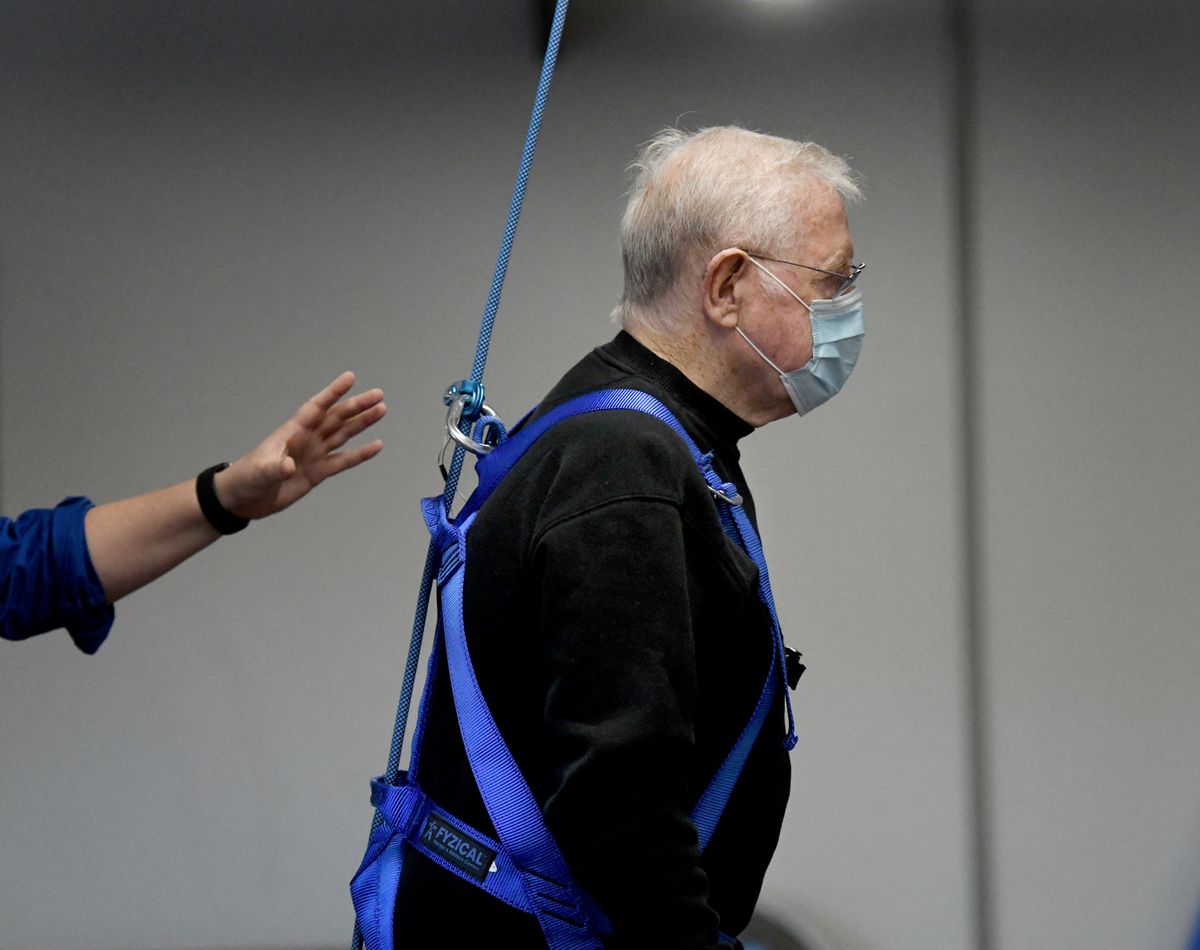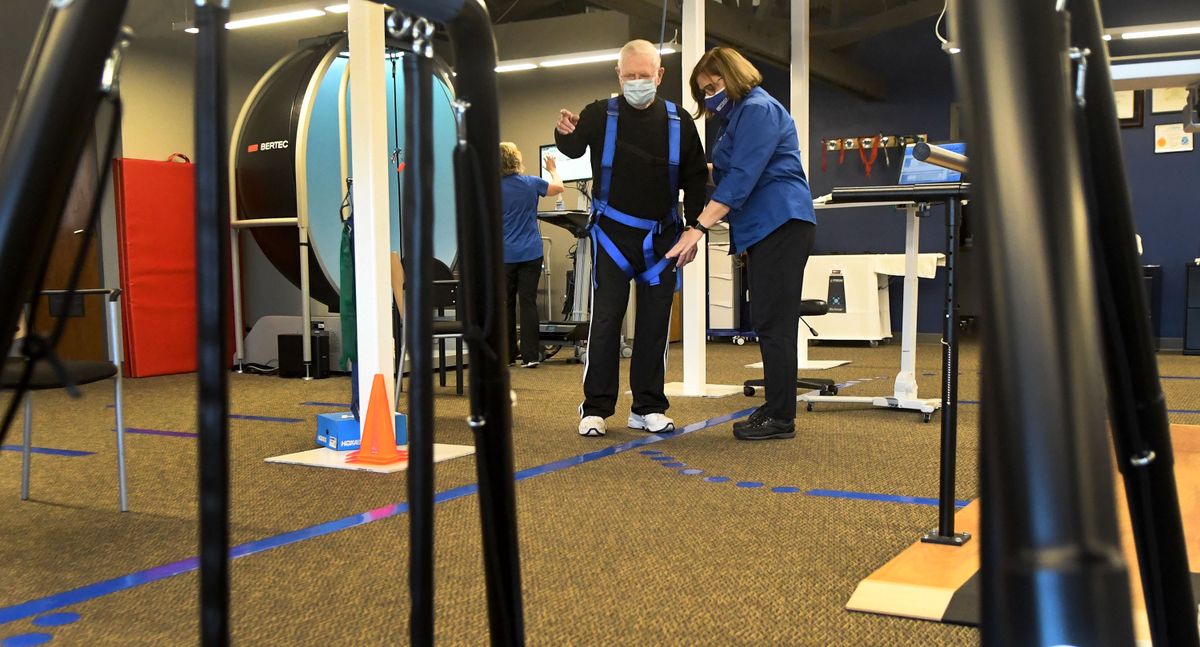Combating inactivity: Physical therapy and balance center sees increase in patients after lengthy pandemic idleness
Gary Paris of Spokane uses the airplane mode of the Bertec Dynamic Balance System at Fyzical Therapy & Balance Center in Spokane on Monday, Oct. 11, 2021. The system works on issues of balance and strength. (Kathy Plonka/The Spokesman-Review)Buy a print of this photo
Physical therapist Tiffany Jenson recently worked with a patient who shared surprise at how much her mobility declined this year. Getting out of a chair proved difficult.
The core issue often is prolonged pandemic inactivity. Many people, especially those older than age 60, have remained more sedentary since COVID-19-related issues impacted communities and activities, said Jenson, who is based at the Spokane site of Fyzical Therapy & Balance Centers.
With more people getting COVID-19 vaccinations, however, the center has handled a spike in patient referrals to help people regain mobility and balance. The center also works with the patients to prevent falls.
“It’s pandemic-related problems just from being sedentary and not being able to be mobile out in the community with social events and interactions canceled,” Jenson said. She said being more sedentary crosses over into chronic issues of increasing weakness, decreasing balance abilities and lack of confidence in mobility.
“Now, people feel like they need and especially want to be out and about and get their mobility back. We are definitely very busy currently after people have been out of their normal routines for over a year. People put a lot of their medical issues on hold during the main time of COVID.”
The Florida-based company is in 430 locations nationwide. The Spokane site is doctor-owned and affiliated with Columbia Surgical Specialists – primarily working with its Ears, Nose & Throat Center. It opened three years ago.
Doctors here had noticed more patients having chronic issues with balance and dizziness, so they developed the center, Jenson said. While a number of patients are referred by that physicians’ group, the local Fyzical also receives referrals from other doctors in Spokane.
Located on Washington Street near Cataldo Avenue, the center applies Fyzical’s specialized technology and equipment, Jenson said. It includes an overhead rail support system, as a patient wears a harness with attached climbing ropes to walk and do guided movements.
“They can’t fall, and that makes people who are really fearful feel a lot safer,” Jenson said. “They’re much more willing to push themselves and try things.” The system also allows for movements in a single area on the rail where the person isn’t mobile and can do standing exercises.
Therapists assess a person’s strength, flexibility and balance to recommend exercises with the appropriate safety, intensity and frequency, she said.
Fyzical uses its computerized balance assessment equipment to determine a baseline. The technology helps assess impairments related to balance, Jenson added. Significant changes to mobility, which has occurred during COVID-19 times, can dramatically impact how the brain uses sensory input to know where the individual is in space.
Therapists work on balance retraining based on a concept called “sensory weighting,” she said.
“How we orient in space is we primarily use three sensory resources. We use our vision, we use information from our body that is sensory information coming to our brain from nerves in skin, muscles and joints. The third is the vestibular system,” part of the inner ear used in balance.
“In any given moment, our brain uses those three resources and weighs them. Which is the sensory resource that is most accurate at this point in time? Which is the most available?”
When your mobility changes, and you sit most of the time, the brain becomes more reliant on that sensory input in contact with a large surface. And your reliance on all three sensory resources can get out of balance, she said.
That can mean when getting up from a chair, you feel unsteady or even dizzy as reliance on threefold sensory feedback is significantly decreased.
“We have the capability at Fyzical to do some computerized balance testing. The test itself is called the sensory organization test.”
It tells staff about how an individual is using the three sensory resources, to encourage exercises that promote what is underused and to strengthen them. It might mean standing while using variable support positions. “We try to re-create this balancing act,” she said.
Meanwhile, there’s work on strength exercises, range of movement and flexibility, as well, Jenson said.
“Our ability to balance is a really complex thing. There are so many factors not only in just our vision, body inputs and inner ear, but our strength, reaction times, cognitive functioning, how you enter an environment and problem solve.”
With complexities, the work is fascinating and almost always means a person can improve, Jenson said.
The centers have a motto, she said. “We perceive balance to be core to wellness, so when there are issues that affect our balance confidence, it affects our wellness in general.”
Most insurances, especially Medicare, require a physician’s referral to pay for such treatment, although primary care physicians doing an annual physical for Medicare patients now do a fall risk assessment and can refer.
Family members also can watch for warning signs in a senior adult that include problems making a transition from sitting to standing, increased difficulty going up and down stairs and a lack of confidence in mobility.
“They tend to start to restrict activities outside of their home because they’re fearful of being out in the community and having to maneuver stairs, curbs and different environments and surfaces,” Jenson said. “You’re noticing as they move through the house, they’re wanting to hang onto counters or furniture for added stability.”
Spouses or relatives also might notice changes in walking speed or posture. Instead of upright and confident, the elder is more forward bent or in a protective stance.
For people who don’t have mobility issues and want to increase activity, Jenson shared ideas for a safe return. Walking is one of the best ways, but if you’ve been sedentary, stay on level surfaces for short distances at first. Go with a friend. Other tips include the following:
• Check with a primary physician about resuming exercise.
• Listen to your body and don’t overdo.
• Go when the lighting is good.
• Pay attention to any pain.
Some senior programs or exercise centers offer fall prevention programs, Jenson added. A primary care doctor can help direct that.
Physical therapists such as herself offer assessments and monitor progress. But especially now, they’re also providing some emotional and mental benefits, Jenson said.
“We’re here to listen and encourage and take that journey back to wellness because it’s been lonely and isolating with the emotional impact of the pandemic,” she said. “People need to be here, but they may say, ‘It’s nice to have someone to talk to.’ Our seniors have suffered the most. They don’t tend to have people with them as often.”


